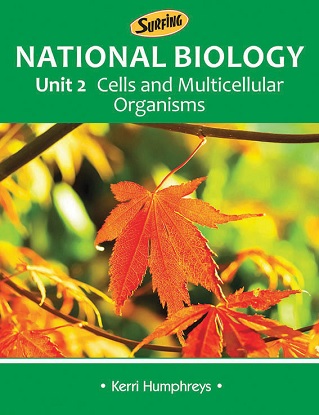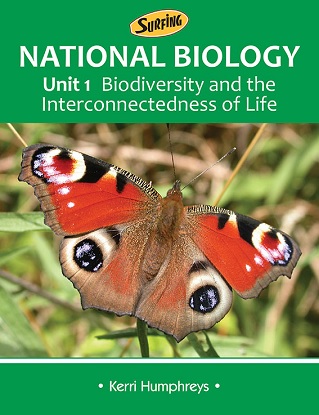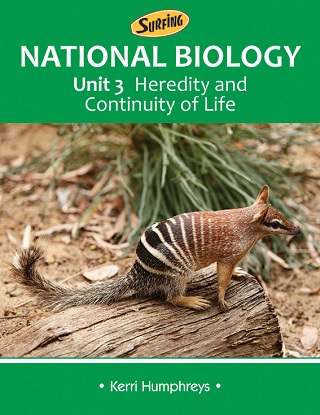National Surfing Biology Unit 2
- Kerri Humphreys
- Science Press
- 2015
- ISBN: 9780855836801
RRP: $49.95 (Inc. GST)

Description
Each book in the Surfing series contains a summary, with occasional more detailed sections, of all the mandatory parts of the syllabus, along with questions and answers.
All types of questions – multiple choice, short response, structured response and free response – are provided.
Questions are written in exam style so that you will become familiar with the concepts of the topic and answering questions in the required way.
Answers to all questions are included.
A topic test at the end of the book contains an extensive set of summary questions. These cover every aspect of the topic, and are useful for revision and exam practice.
Table of Contents
Introduction
Words to Watch
Cells as the Basis of Life
1 Assumed Knowledge
2 Characteristics of Living Things
3 Developing the Cell Theory
4 Cell Theory and Robert Hooke
5 Cell Theory and Robert Brown
6 Technology and the Development of the Cell Theory
7 The Modern Light Microscope
8 The Electron Microscope
9 The Stereo Microscope
10 Experiment – The Light Microscope
11 Experiment – Using a Light Microscope
12 Experiment – Making a Wet Mount
13 Experiment – Drawing Biological Diagrams
14 Writing a Practical Report
15 The Light Microscope and Cell Organelles
16 Experiment – Plant Cells
17 Experiment – Animal Cells
18 The Electron Microscope and Cell Organelles
19 Mitochondria
20 Chloroplasts
21 Golgi Bodies
22 Development of the Model of the Cell Membrane
23 Cell Organelles Summary
24 Chemicals in Cells
25 Experiment – Substances in Tissues
26 Cell Input and Output
27 Passive Transport
28 Diffusion
29 Active Transport
30 Movement Across the Cell Membrane
31 Experiment – Membranes, Diffusion and Osmosis
32 Experiment – Surface Area to Volume Ratio and Diffusion
33 Experiment – Plasmolysis
34 Material Exchange and Concentration Gradient
35 Material Exchange and the Nature of the Material
36 Experiment – Surface Area and Rate of Reaction
37 Prokaryotes
38 Eukaryotes
39 Enzymes
40 Enzymes and Reactions
41 Experiment – Enzyme Activity and pH
42 Experiment – Enzyme Activity and Temperature
43 Experiment – Enzyme Activity and Substrate Concentration
44 Enzymes and Inhibitors
45 Allosteric Activation and Inhibition
46 Enzyme Deficiencies
47 Photosynthesis
48 Play – Inside Photosynthesis
49 Light, Chlorophyll and Photosynthesis
50 Experiment – Chlorophyll and Photosynthesis
51 Experiment – Light and Photosynthesis
52 Reactions in Photosynthesis
53 Photosynthesis and Productivity
54 Respiration
55 Reactions in Respiration
Multicellular Organisms
56 Cells, Tissues, Organs and Systems
57 Differentiation and Specialised Cells
58 Stem Cells
59 Human Organ Systems
60 Organ and Tissue Transplantation
61 Bioartificial Organs
62 The Digestive System
63 Teeth
64 Carnivore, Herbivore and Nectar Feeder Digestive Systems
65 Play – Amino and Lipidet, a Most Lamentable Tragedy
66 Respiratory Systems
67 Gas Exchange, Breathing and Ventilation
68 Circulatory Systems in Animals
69 Excretion, Respiration and Water
70 Excretory Organs
71 The Kidney
72 Osmosis and Diffusion
73 Renal Hormones
74 Renal Dialysis
75 Excretion in Other Organisms
76 Plant Tissues and Cells
77 Plant Organs
78 Root Structure
79 Leaves
80 Stomates
81 Experiment – Transpiration
82 Transport Systems in Plants
83 Experiment – Movement in Xylem
84 Adaptations in Plants
85 Radioisotopes Track the Movement of Substances in Organisms
86 Chemical Monitoring
87 Experiment – Carbon Dioxide and pH
88 CAT and MRI Scans
89 Adaptations in Invertebrates
90 Adaptations in Vertebrates
91 Animal Ethics
Topic Test
Answers
Index





